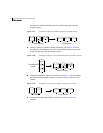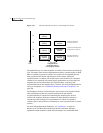
64 Understanding Veritas Volume Manager
Volume snapshots
Figure 1-31 Volume snapshot as a point-in-time image of a volume
The traditional type of volume snapshot in VxVM is of the third-mirror break-off
type. This name comes from its implementation where a snapshot plex (or third
mirror) is added to a mirrored volume. The contents of the snapshot plex are
then synchronized from the original plexes of the volume. When this
synchronization is complete, the snapshot plex can be detached as a snapshot
volume for use in backup or decision support applications. At a later time, the
snapshot plex can be reattached to the original volume, requiring a full
resynchronization of the snapshot plex’s contents. For more information about
this type of snapshot, see “Traditional third-mirror break-off snapshots” on
page 305.
The FastResync feature was introduced to track writes to the original volume.
This tracking means that only a partial, and therefore much faster,
resynchronization is required on reattaching the snapshot plex. In later
releases, the snapshot model was enhanced to allow snapshot volumes to
contain more than a single plex, reattachment of a subset of a snapshot
volume’s plexes, and persistence of FastResync across system reboots or cluster
restarts.
For more information about FastResync, see “FastResync” on page 66.
Release 4.0 of VxVM introduced full-sized instant snapshots and space-
optimized instant snapshots, which offer advantages over traditional third-
Snapshot
volume
Snapshot
volume
Original
volume
Original
volume
Original
volume
Original
volume
Snapshot volume is
created at time T2
Snapshot
volume
Time
T1
T2
T3
T4
Resynchronize
snapshot volume
from original volume
Snapshot volume retains
image taken at time T2
Snapshot volume is
updated at time T4


















